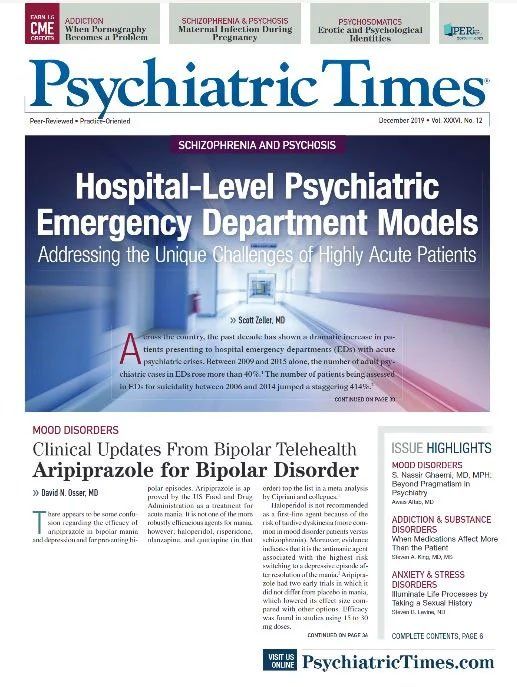Publication
Article
Psychiatric Times
Understanding and Managing Agitation Associated with Dementia
Author(s):
Agitation can worsen function, pose safety concerns, and increase caregiver stress. It can be both confusing and frustrating to understand and manage these behaviors, but there are several approaches that can make all the difference.
©Kzenon/AdobeStock

CONFERENCE REPORTER
Every clinician who works with individuals who have dementia-what we now refer to as major neurocognitive disorders-encounters states of agitation that can worsen function, pose safety concerns, and increase caregiver stress. It can be both confusing and frustrating to understand and manage these behaviors, but there are several approaches that can make all the difference.
Agitation has been defined by the International Psychogeriatric Association as involving excessive motor activity or verbal or physical aggression that causes emotional distress and excess disability for the affected person, and impairs relationships, social functioning, and activities of daily living.1 These behaviors are commonly part of a larger constellation of behavioral and psychological symptoms that are associated with all major forms of dementia, including mania, depression, anxiety, apathy, and psychosis.2
Agitation has many medical, medication-related, psychiatric, psychological, and environmental causes-but underlying all of them is a damaged and vulnerable brain that is less able to properly regulate affect and respond to challenges in an organized manner. Specifically, agitation has been associated with damage to key brain nuclei that regulate cholinergic and serotonergic pathways.3,4
A thorough medical and psychiatric evaluation as well as a review of the circumstances before, during, and after periods of agitation may reveal both enduring causes, such as an underlying depression or the use of a stimulating medication, and transient triggers such as boredom, hunger, or a noxious stimulus in the environment. The DICE algorithm developed by Kales and colleagues5 is an excellent tool for clinicians as it guides them to describe the behaviors in detail, investigate potential causes, create a team approach to implement various treatments, and then to evaluate the relative success of the interventions.
Management of agitation involve three basic approaches. The first is to identify and address potential causes. The second is to implement behavioral approaches, ranging from increased therapeutic activities (eg, art or music therapy), to redirecting and refocusing the person to more positive activities, especially ones that meet the basic function of the agitation in the first place. The third approach involves the use of psychotropic medications that are targeted towards underlying factors such as anxiety or psychosis, or primarily aimed at reducing agitation by calming brain activity. Benzodiazepines and trazodone are often used emergently but can cause sedation and increase the risk of falling. Antidepressants are being studied since their modulation of serotonergic activity is aimed at reducing impulsivity and aggression. Anticonvulsants have been used to inhibit brain activity causing agitation, but with limited scientific support.
Antipsychotic medications have been widely studied, and while there is a fair amount of evidence suggesting modest benefit for agitation, there are also significant safety concerns, including the black box warnings for an increased risk of death.6 With any pharmacologic approach, the goal is to use the least amount of medication for the shortest time possible. Finally, clinicians need to be aware of the many regulations concerning the use of psychotropic medications in long-term care settings, including guidelines from the Omnibus Budget Reconciliation Act (OBRA) of 1987 guidelines, American Geriatrics Society Beers Criteria, and definitions of unnecessary drug use.
The best outcome will always stem from a systematic approach that seeks to understand and address the underlying causes and triggers of agitation, and then implements and evaluates both behavioral and pharmacologic approaches, with a clear eye on safety.
This article was originally posted on 10/8/19 and has since been updated.
Disclosures:
Dr Agronin is a geriatric psychiatrist and currently serves as the Senior Vice President for Behavioral Health and the Chief Medical office at MIND Institute at Miami Jewish Health in Miami, FL. He is the author of The Dementia Caregiver: A Guide to Caring for Someone with Alzheimer’s Disease and Other Neurocognitive Disorders. Dr Agronin was a speaker at the 2019 Psych Congress in San Diego, CA, he presented “Behavioral and Pharmacologic Approaches to Agitation and Dementia Associated with Major Neurocognitive Disorders.”
The author reports no disclosures concerning the subject matter of this article.
References:
1. Cummings J, Mintzer J, Brodaty H, et al. Agitation in Cognitive Disorders. International Psychogeriatric Association provisional consensus clinical and research definition. Int Psychogeriatr. 2015;27:7-17.
2. Lyketsos CG, Carrillo MC, Ryan JM, et al. Neuropsychiatric symptoms in Alzheimer's disease. Alzheimers Dement. 2011;7:532-539.
3. Sultzer DL, Mahler ME, Mandelkern MA, et al. The relationship between psychiatric symptoms and regional cortical metabolism in Alzheimer's disease. J Neuropsychiatry Clin Neurosci. 1995;7:476-484.
4. McLoughlin DM, Lucey JV, Dinan TG. Central serotonergic hyperresponsivity in late-onset Alzheimer's disease. Am J Psychiatry. 1994;151:1701-1703.
5. Kales HC, Gitlin LN, Lyketsos CG; Detroit Expert Panel on Assessment and Management of Neuropsychiatric Symptoms of Dementia. Management of neuropsychiatric symptoms of dementia in clinical settings: recommendations from a multidisciplinary expert panel. J Am Geriatr Soc. 2014;62:762-769.
6. Tampi RR, Tampi DJ, Balachandran S, Srinivasan S. Antipsychotic use in dementia: a systematic review of benefits and risks from meta-analyses. Ther Adv Chronic Dis. 2016;7:229-245.






